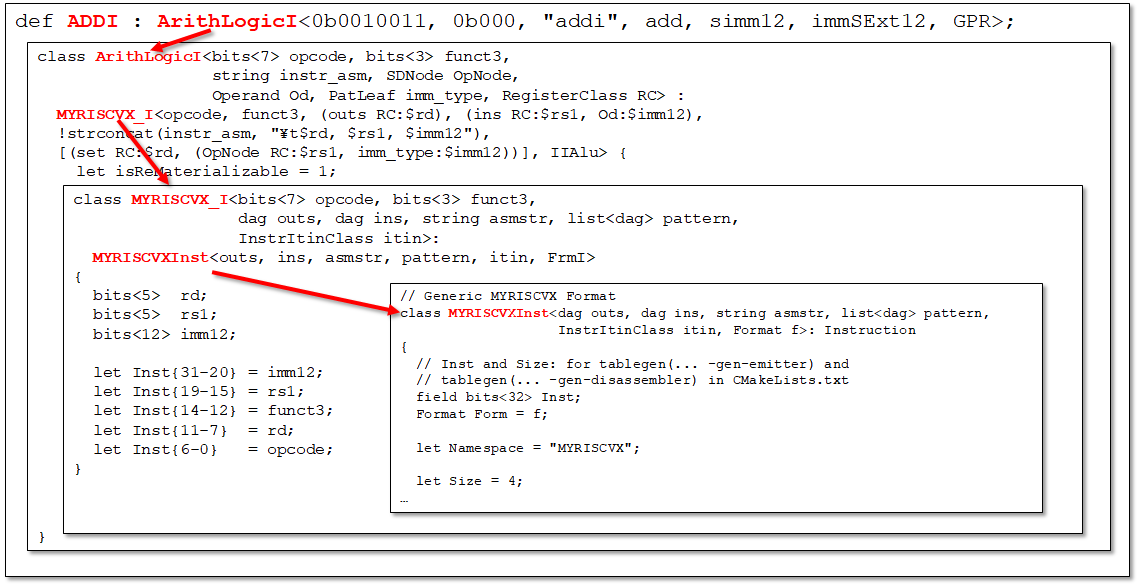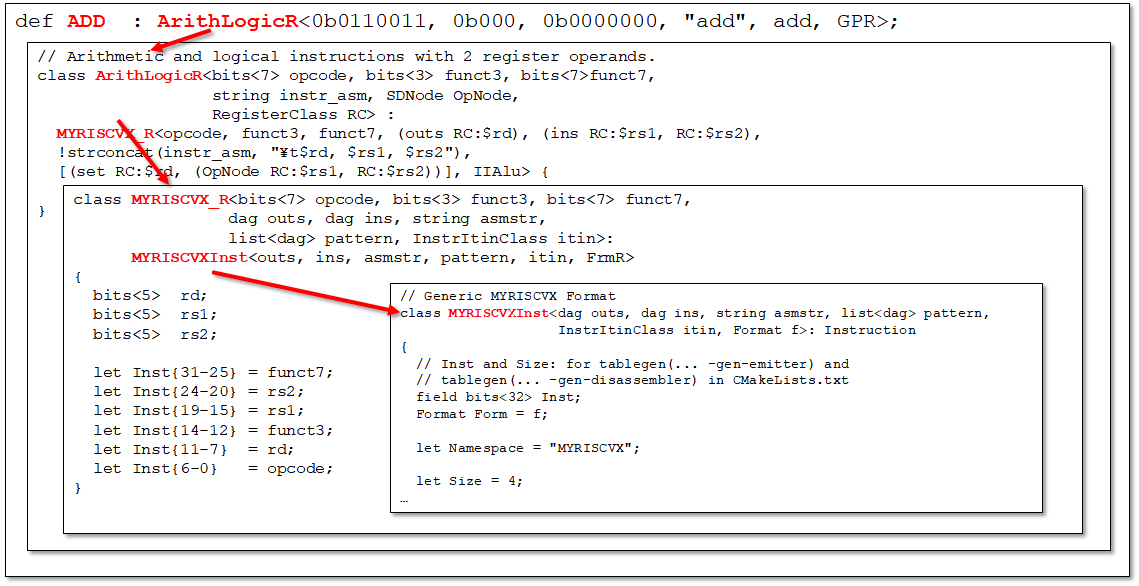
定数が生成できるようになったので、次は演算命令を追加する。
こちらも同様にMYRISCVXInstrInfo.tdに命令パタンを追加していく。
llvm-myriscvx/lib/Target/MYRISCVX/MYRISCVXInstrInfo.td
def ADDI : ArithLogicI<0b0010011, 0b000, "addi", add, simm12, immSExt12, GPR>; def XORI : ArithLogicI<0b0010011, 0b100, "xori", xor, uimm12, immZExt12, GPR>; def ORI : ArithLogicI<0b0010011, 0b110, "ori", or, uimm12, immZExt12, GPR>; def ANDI : ArithLogicI<0b0010011, 0b111, "andi", and, uimm12, immZExt12, GPR>; def LUI : ArithLogicU<0b0110111, "lui", GPR, simm20, immSExt20>; def ADD : ArithLogicR<0b0110011, 0b000, 0b0000000, "add", add, GPR>; def SUB : ArithLogicR<0b0110011, 0b000, 0b0100000, "sub", sub, GPR>; def SLL : shift_rotate_reg<0b0110011, 0b0000000, 0b001, 0x0, "sll", shl, GPR>; def AND : ArithLogicR<0b0110011, 0b111, 0b0000000, "and", and, GPR>; def SRL : shift_rotate_reg<0b0110011, 0b0000000, 0b101, 0x0, "srl", srl, GPR>; def SRA : shift_rotate_reg<0b0110011, 0b0100000, 0b101, 0x0, "sra", sra, GPR>; def OR : ArithLogicR<0b0110011, 0b110, 0b0000000, "or", or, GPR>; def XOR : ArithLogicR<0b0110011, 0b100, 0b0000000, "xor", xor, GPR>;
ArithLogicI, ArithLogicRの定義を見直してみる。
// Arithmetic and logical instructions with 2 register operands.
class ArithLogicR<bits<7> opcode, bits<3> funct3, bits<7>funct7,
string instr_asm, SDNode OpNode,
RegisterClass RC> :
MYRISCVX_R<opcode, funct3, funct7, (outs RC:$rd), (ins RC:$rs1, RC:$rs2),
!strconcat(instr_asm, "\t$rd, $rs1, $rs2"),
[(set RC:$rd, (OpNode RC:$rs1, RC:$rs2))], IIAlu> {
let isReMaterializable = 1;
}
// Arithmetic and logical instructions with 2 register operands.
class ArithLogicI<bits<7> opcode, bits<3> funct3,
string instr_asm, SDNode OpNode,
Operand Od, PatLeaf imm_type, RegisterClass RC> :
MYRISCVX_I<opcode, funct3, (outs RC:$rd), (ins RC:$rs1, Od:$imm12),
!strconcat(instr_asm, "\t$rd, $rs1, $imm12"),
[(set RC:$rd, (OpNode RC:$rs1, imm_type:$imm12))], IIAlu> {
let isReMaterializable = 1;
}
例えば、
def ADD : ArithLogicR<0b0110011, 0b000, 0b0000000, "add", add, GPR>;
の場合、
MYRISCVX_Rクラスをベースに扱う。- 命令ニーモニックは
!strconcat(instr_asm, "\t$rd, $rs1, $rs2")→add\t$rd, $rs1, $rs2となる。 - 命令の動作パタンは、
(set RC:$rd, (add RC:$rs1, RC:$rs2))


となる。これを、算術演算、論理演算について定義して行く。
シフト命令は特殊なフォーマットを定義して、即値、レジスタ指定両方のフォーマットを決める。
llvm-myriscvx/lib/Target/MYRISCVX/MYRISCVXInstrInfo.td
class MYRISCVX_ISHIFT<bits<7> opcode, bits<3> funct3, bit arithshift,
dag outs, dag ins, string asmstr, list<dag> pattern,
InstrItinClass itin>:
MYRISCVXInst<outs, ins, asmstr, pattern, itin, FrmI>
{
bits<5> rs1;
bits<5> rd;
bits<6> shamt;
let Inst{31} = 0;
let Inst{30} = arithshift;
let Inst{29-26} = 0;
let Inst{25-20} = shamt;
let Inst{19-15} = rs1;
let Inst{14-12} = funct3;
let Inst{11-7} = rd;
let Inst{6-0} = opcode;
}
llvm-myriscvx/lib/Target/MYRISCVX/MYRISCVXInstrInfo.td
// Shifts
class ShiftImm<bits<7> opcode, bits<3> funct3, bit arithshift, string instr_asm,
SDNode OpNode, PatFrag PF, Operand ImmOpnd,
RegisterClass RC>:
MYRISCVX_ISHIFT<opcode, funct3, arithshift, (outs RC:$rd), (ins RC:$rs1, ImmOpnd:$shamt),
!strconcat(instr_asm, "\t$rd, $rs1, $shamt"),
[(set GPR:$rd, (OpNode RC:$rs1, PF:$shamt))], IIAlu> {
}
// 32-bit shift instructions.
class ShiftImm32<bits<7> opcode, bits<3> funct3, bit arithshift, string instr_asm,
SDNode OpNode>:
ShiftImm<opcode, funct3, arithshift, instr_asm, OpNode, immZExt5, shamt, GPR>;
class ShiftR<bits<7> opcode, bits<7> funct7, bits<3> funct3,
bits<4> isRotate, string instr_asm,
SDNode OpNode, RegisterClass RC>:
MYRISCVX_R<opcode, funct3, funct7, (outs RC:$ra), (ins RC:$rb, RC:$rc),
!strconcat(instr_asm, "\t$ra, $rb, $rc"),
[(set GPR:$ra, (OpNode RC:$rb, RC:$rc))], IIAlu> {
}
ShiftRとShiftImm32を使って、即値とレジスタ指定のシフト命令を定義する。
llvm-myriscvx/lib/Target/MYRISCVX/MYRISCVXInstrInfo.td
def SLL : ShiftR<0b0110011, 0b0000000, 0b001, 0x0, "sll", shl, GPR>; def SRL : ShiftR<0b0110011, 0b0000000, 0b101, 0x0, "srl", srl, GPR>; def SRA : ShiftR<0b0110011, 0b0100000, 0b101, 0x0, "sra", sra, GPR>; def SRLI : ShiftImm32<0b0010011, 0b101, 0, "srli", srl>; def SLLI : ShiftImm32<0b0010011, 0b001, 0, "slli", shl>; def SRAI : ShiftImm32<0b0010011, 0b101, 1, "srai", sra>;
まず、LLVM IRが正しく命令に変換されるかテストしてみる。以下のch4_math.llを使用する。
; Function Attrs: nounwind
define i32 @_Z9test_mathv() #0 {
%a = alloca i32, align 4
%b = alloca i32, align 4
%1 = load i32, i32* %a, align 4
%2 = load i32, i32* %b, align 4
%3 = add nsw i32 %1, %2
%4 = sub nsw i32 %1, %2
%5 = mul nsw i32 %1, %2
%6 = shl i32 %1, 2
%7 = ashr i32 %1, 2
%8 = lshr i32 %1, 30
%9 = shl i32 1, %2
%10 = ashr i32 128, %2
%11 = ashr i32 %1, %2
%12 = add nsw i32 %3, %4
%13 = add nsw i32 %12, %5
%14 = add nsw i32 %13, %6
%15 = add nsw i32 %14, %7
%16 = add nsw i32 %15, %8
%17 = add nsw i32 %16, %9
%18 = add nsw i32 %17, %10
%19 = add nsw i32 %18, %11
ret i32 %19
}
./bin/llc -debug -march=myriscvx32 -mcpu=simple32 -mattr=+64bit -relocation-model=pic -filetype=asm ../lbdex/input/ch4_math.ll -o -
.globl _Z9test_mathv # -- Begin function _Z9test_mathv
.type _Z9test_mathv,@function
.ent _Z9test_mathv # @_Z9test_mathv
_Z9test_mathv:
.cfi_startproc
.frame $x8,8,$x1
.mask 0x00000000,0
.set noreorder
.set nomacro
discovered a new reachable node %bb.0
# %bb.0:
addi x2, x2, -8
.cfi_def_cfa_offset 8
lw x10, 0(x2)
lw x11, 4(x2)
sub x12, x11, x10
add x13, x11, x10
add x12, x13, x12
mul x13, x11, x10
add x12, x12, x13
slli x13, x11, 2
add x12, x12, x13
srai x13, x11, 2
add x12, x12, x13
srli x13, x11, 30
add x12, x12, x13
addi x13, zero, 1
sll x13, x13, x10
add x12, x12, x13
sra x11, x11, x10
addi x13, zero, 128
srl x10, x13, x10
add x10, x12, x10
add x10, x10, x11
addi x2, x2, 8
ret x1
.set macro
.set reorder
.end _Z9test_mathv
$func_end0:
.size _Z9test_mathv, ($func_end0)-_Z9test_mathv
.cfi_endproc
# -- End function
.section ".note.GNU-stack","",@progbits
命令が生成されていることが確認できた。なかなか良さそうだ。
さらに、乗除算命令を追加する。
llvm-myriscvx/lib/Target/MYRISCVX/MYRISCVXInstrInfo.td
def MUL : ArithLogicR<0b0110011, 0b000, 0b0000001, "mul", mul, GPR>; def MULH : ArithLogicR<0b0110011, 0b001, 0b0000001, "mulh", mulhs, GPR>; def MULHSU: ArithLogicR<0b0110011, 0b010, 0b0000001, "mulhsu", mulhs, GPR>; def MULHU : ArithLogicR<0b0110011, 0b011, 0b0000001, "mulhu", mulhu, GPR>; def DIV : ArithLogicR<0b0110011, 0b100, 0b0000001, "div", sdiv, GPR>; def DIVU : ArithLogicR<0b0110011, 0b101, 0b0000001, "divu", udiv, GPR>; def REM : ArithLogicR<0b0110011, 0b110, 0b0000001, "rem", srem, GPR>; def REMU : ArithLogicR<0b0110011, 0b111, 0b0000001, "remu", urem, GPR>;
これで乗除算命令が生成できるようになる。
int test_mult() { int a = 12; int b = 11; b = a * b; return b; }
./bin/clang -target mips-unknown-linux-gnu -c ../lbdex/input/ch4_1_multtest.cpp -emit-llvm ./bin/llc -debug -march=myriscvx32 -mcpu=simple32 -mattr=+64bit -relocation-model=pic -filetype=asm ch4_1_multtest.bc -o -
# %bb.0: # %entry
addi x2, x2, -8
addi x10, zero, 12
sw x10, 4(x2)
addi x10, zero, 11
sw x10, 0(x2)
lw x10, 4(x2)
lw x11, 0(x2)
mul x10, x10, x11
sw x10, 0(x2)
lw x10, 0(x2)
addi x2, x2, 8
ret x1
.set macro
.set reorder
.end _Z9test_multv
$func_end0: